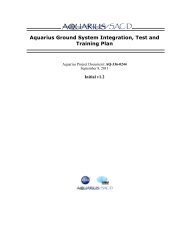STUMPF, RICHARD P., KRISTINE HOLDERIED, AND ... - Ocean Color
STUMPF, RICHARD P., KRISTINE HOLDERIED, AND ... - Ocean Color
STUMPF, RICHARD P., KRISTINE HOLDERIED, AND ... - Ocean Color
You also want an ePaper? Increase the reach of your titles
YUMPU automatically turns print PDFs into web optimized ePapers that Google loves.
Limnol. <strong>Ocean</strong>ogr., 48(1, part 2), 2003, 547–556 2003, by the American Society of Limnology and <strong>Ocean</strong>ography, Inc.Determination of water depth with high-resolution satellite imagery over variablebottom typesRichard P. Stumpf 1 and Kristine HolderiedNOAA National <strong>Ocean</strong> Service, Center for Coastal Monitoring and Assessment, 1305 East–West Highway rm 9115,Silver Spring, Maryland 20910Mark SinclairTenix LADS Corporation, Mawson Park, South Australia, 5095, AustraliaAbstractA standard algorithm for determining depth in clear water from passive sensors exists; but it requires tuning offive parameters and does not retrieve depths where the bottom has an extremely low albedo. To address these issues,we developed an empirical solution using a ratio of reflectances that has only two tunable parameters and can beapplied to low-albedo features. The two algorithms—the standard linear transform and the new ratio transform—were compared through analysis of IKONOS satellite imagery against lidar bathymetry. The coefficients for theratio algorithm were tuned manually to a few depths from a nautical chart, yet performed as well as the linearalgorithm tuned using multiple linear regression against the lidar. Both algorithms compensate for variable bottomtype and albedo (sand, pavement, algae, coral) and retrieve bathymetry in water depths of less than 10–15 m.However, the linear transform does not distinguish depths 15 m and is more subject to variability across thestudied atolls. The ratio transform can, in clear water, retrieve depths in 25 m of water and shows greater stabilitybetween different areas. It also performs slightly better in scattering turbidity than the linear transform. The ratioalgorithm is somewhat noisier and cannot always adequately resolve fine morphology (structures smaller than 4–5pixels) in water depths 15–20 m. In general, the ratio transform is more robust than the linear transform.Since the first use of aerial photography over clear shallowwater, it has been recognized that water depth can be estimatedin some way by remote sensing. The theory developedby Lyzenga (1978, 1981) and expanded by Philpot (1989)and Maritorena et al. (1994) demonstrated the validity of,and problems involved with, using passive remote sensingfor determination of water depth. The use of two or morebands allows separation of variations in depth from variationsin bottom albedo, but compensation for turbidity, whiletractable, can be problematic. Although passive optical systemsare limited in depth penetration and constrained by waterturbidity, the use of such satellite data might be the onlyviable way to characterize either extensive or remote coralreef environments. Besides the obvious need for bathymetricinformation in many remote areas, mapping of coral reefsand characterization of potential for bleaching requires informationon water depth. Coral reefs, by their nature,strongly influence the physical structure of their environment,and water depth information is fundamental to discriminatingand characterizing coral reef habitat, such aspatch reef, spur-and-groove, and seagrass beds. Knowledgeof water depth also allows estimation of bottom albedo,which can improve habitat mapping (Mumby et al. 1998).Knowledge of the detailed structure of the bottom helps in1Corresponding author (richard.stumpf@noaa.gov).AcknowledgmentsThis effort was funded by the NOAA, National <strong>Ocean</strong> Service,Coral Reef Mapping Program. Steve Rohmann provided overall coordinationof the Northwestern Hawaiian Islands project. The mentionof any company does not constitute an official endorsement byNOAA.547characterizing the role and quality of the reef as a fish environment.However, extensive areas of coral reefs in theocean have little, incomplete, or spatially limited data onbathymetry because of the difficulty obtaining accurate andwell-distributed soundings in remote reef areas. A robustmethod of estimating bathymetry directly from the passivesatellite imagery would enhance our capability to map theseregions.In order to map coral reef environments, high spatial resolutionis required because of the relatively small horizontalspatial scales and the ecological importance of vertical structuresin those environments in the form of patch reefs, spurand-groove,mini-atolls, and so on. Mapping the fine-scalevariability will improve characterization of habitat, both forcorals and for various species living in the reefs. Until recently,only two options existed for such information: airbornemeasurements (photo and hyperspectral) and multispectralsatellite imagery (typically Landsat). Althoughaircraft can provide high-resolution data, either spatially orspectrally, high costs and deployment issues limit their usefor comprehensive regional mapping in remote areas. Landsat,particularly the Landsat-7 enhanced thematic mapper(ETM), offers global coverage of coral reefs, but only witha 30-m field of view. With the launch of high-resolutionsensors IKONOS in 1999 and QuickBird in 2002, 4-m (orbetter) field-of-view multispectral imagery became availablefrom space, providing a new resource for the developmentof mapping and monitoring programs for coral reefs in remotelocations. These systems provide multispectral datawith three visible bands (blue, green, red), which can simulateaerial photography, and one near-infrared (near-IR)band. This study focuses on IKONOS imagery; however, the
548 Stumpf et al.Table 1. Spectral bands for IKONOS, with Landsat-7 ETM forcomparison.Spectral regionBlueGreenRedNear-infraredIKONOS445–515510–595630–700760–850Spectral bands (nm)Landsat-7450–520530–610630–690780–900same depth estimation methods can be applied to Landsatimagery because of the similarity in the spectral bands (Table1).The standard bathymetry algorithm has a theoretical derivation(Lyzenga 1978) but also incorporates empirical tuningas an inherent part of the depth estimation process. It ispreferable to minimize such tuning, particularly for remoteregions where benthic and water quality parameters can behard to measure or estimate. This paper examines an alternativebathymetry algorithm and addresses two basic problemsin the application of bathymetry algorithms to mappingcoral reefs: (1) the stability of an algorithm with fixed coefficientswithin and between atolls and (2) the behavior ofthe algorithms in describing relative and absolute depths atvarious scales.Materials and methodsStudy area—The area under investigation in this paperincludes two coral reef atolls in the northwest Hawaiian Islands.This island chain extends over 1,800 km of the northPacific from Nihoa Island at 162W to Kure Atoll at178.5W. The area encompasses two National Wildlife Refuges,a Hawaiian State Wildlife Sanctuary, and the new U.S.Northwestern Hawaiian Islands Coral Reef Ecosystem Reserve,which is proposed for designation as a U.S. NationalMarine Sanctuary. There are 10 emergent atolls and reefsand several shallow banks. The reef and bank areas include7,000 km 2 of area less than 25 fathoms (45 m) in depth(the absolute maximum depth detectable by passive remotesensing and a boundary demarcation for some regulated activitieswithin the Reserve), making it the largest shallowwatercoral reef area under direct U.S. jurisdiction. The areais remote, and the two atolls discussed here, Kure Atoll andPearl and Hermes Reef (henceforth called Pearl), are locatednearly 2,000 km from Honolulu. The shallow-water environmentsof these two atolls are considerable in area, with100 km 2 at Kure and 500 km 2 at Pearl. Kure Atoll was hometo a U.S. Coast Guard Loran station and has accurate soundingswithin the lagoon, but few or no soundings in the forereefarea. In addition, outside of a narrow corridor to themain island, many of the Kure reefs are not mapped in sufficientdetail to assure confidence in navigation. Even withthese limitations, Kure has more depth information thanPearl, where one third of the lagoon has no bathymetric informationat all, and the charts show only the general formof the maze of mini-atolls and extensive lines of reticulatedreefs within the lagoon.The atolls have substrates varying from sand to pavementto live coral, with cover that includes various densities ofalgae and smaller corals. The sand is usually coralline andwhite with an extremely high albedo in higher energy areas.With an increasing proportion of coral gravel and rubble, thesediments tend to have a tan or brown appearance. Pavementis typically gray to olive brown in appearance, varies fromlow to high rugosity, and is often covered with varying densitiesof algae. In areas where coral is found at high densityat Kure and Pearl, Porites compressa (finger coral) is themost common species, with other dominant corals includingMontipora capitata (rice coral), Porites lobata (lobe coral),Montipora flabellata (blue rice coral), and Pocilloporameandrina (cauliflower coral). Algal cover includes varietiesof red, brown, and green macroalgae, as well as filamentousturf algae. The reef flats are typically dominated by encrustingcoralline algae, with some green algae (e.g., Halimedasp.).Model—The depth estimation method uses the reflectancesfor each satellite imagery band, calculated with the sensorcalibration files and corrected for atmospheric effects. Thereflectance of the water, R w , which includes the bottomwhere the water is optically shallow, is defined asL w()Rw (1)E d()where L w is the water-leaving radiance, E d is the downwellingirradiance entering the water, and is the spectral band.L w and R w refer to values above the water surface. R w isfound by correcting the total reflectance R T for the aerosoland surface reflectance, as estimated by the near-IR band,and for the Rayleigh reflectance R r (Eq. 2).R w R T ( i ) Y( i )R T ( IR ) R r ( i ) (2)Y is the constant to correct for spectral variation (equivalentto the Angstrom exponent in Gordon et al. [1983]), subscripti denotes a visible channel, and subscript IR denotes thenear-IR channel. R T is found from Eq. 3.L T( i)/E 0( i)R T( i) (3)2(1/r )T ( )T ( )cos 0 i 1 i 0L T is the (total) radiance measured at the satellite, E 0 is thesolar constant, r is the earth–sun distance in astronomicalunits, 0 is the solar zenith angle, and T 0 and T 1 are thetransmission coefficients for sun-to-earth and earth-to-satellite,respectively.The atmospheric correction is based on the algorithm developedby Gordon et al. (1983) for the Coastal Zone <strong>Color</strong>Scanner (CZCS) and by Stumpf and Pennock (1989) for theAdvanced Very High Resolution Radiometer (AVHRR) andis similar to that recommended for Landsat (Chavez 1996;Zhang et al. 1999). The Y coefficient in Eq. 2 depends onaerosol type. For IKONOS, the correction presumes a maritimeatmosphere with a spectral variation similar to that ofthe water surface specular reflectance. This proves to be areasonable assumption here; however, separation of the aerosolcorrection (with a scale of hundreds of meters) from thespecular surface reflectance correction (with a scale of tens
Satellite-derived water depth549of meters) might be required for more generic use of IKO-NOS data. Although IKONOS does not have onboard calibration,postlaunch calibrations have been established by thecommercial vendor, Space Imaging. Additional comparisonswith Landsat-7, which does have onboard calibration, as wellas the sea-viewing wide field-of-view sensor (SeaWiFS),might aid in calibration for future work. Residual miscalibrationwill result in alteration of the atmospheric model ofchoice and, to a lesser degree, in the empirical coefficientschosen for the depth estimation algorithms.Bathymetry—Linear transform: Light is attenuated exponentiallywith depth in the water column, with the changeexpressed by Beer’s Law (Eq. 4).L(z) L(0)exp(Kz) (4)K is the attenuation coefficient and z is the depth. Any analysisof light with depth must take into account this exponentialdecrease in radiance with depth. Lyzenga (1978)showed that the relationship of observed reflectance (or radiance)to depth and bottom albedo could be described asR w (A d R )exp(gz) R (5)where R is the water column reflectance if the water wereoptically deep, A d is the bottom albedo, z is the depth, andg is a function of the diffuse attenuation coefficients for bothdownwelling and upwelling light. Equation 5 can be rearrangedto describe the depth in terms of the reflectances andthe albedo (Eq. 6).z g 1 [ln(A d R ) ln(R w R )] (6)The estimation of depth from a single band using Eq. 6will depend on the albedo A d , with a decrease in albedoresulting in an increase in the estimated depth. Lyzenga(1978, 1985) showed that two bands could provide a correctionfor albedo in finding the depth and created from Eq.6 the linear solution in Eq. 7.Z a 0 a i X i a j X j (7)whereX i ln[R w ( i ) R ( i )] (8)The constants a 0 ,a i , and a j usually are determined from multiplelinear regression (or a similar technique). For any solutionfor depth from passive systems, variations in waterclarity and spectral variation in absorption pose additionalcomplications (Philpot 1989; Van Hengel and Spitzer 1991).The linear transform solution above has five variables thatmust be determined empirically: R ( i ), R ( j ), a 0 ,a i , and a j .Having to adjust five empirical coefficients can be problematicfor large areas, even with relatively small variations inwater quality conditions. In addition, when the bottom albedois low, as can occur with dense macroalgae or seagrass,then A d is less than R . As a result, the depth cannot be foundwithout using an entirely new algorithm, because X is undefinedif (R w R ) is negative (logarithm of a negativenumber).Fig. 1. Log transformation used for ratio algorithm with datafrom Kure Atoll. The lines of constant depth are also lines of fixedratio (0.3 m is also the blue to green ratio of 0.975; 18 m is a ratioof 1.251). Depths were assigned to the constant ratio lines using thetuning described in this paper. The dashed line shows the approximatevalues for a sand bottom that has the same albedo at all depths.The attenuation of light with depth means that features have lowerR w in deeper water, regardless of their intrinsic albedo. A decreasein albedo causes values to move down the lines of constant ratio.‘‘High A d ’’ indicates carbonate sand of nominally similar albedo atboth 0.3 and 18 m. ‘‘Low A d ’’ indicates similar albedo over densealgal cover at both depths.Ratio transform: The problem of mapping shallow-waterareas with significantly lower reflectance than adjacent, opticallydeep waters provided the initial motivation to developan alternative algorithm. Because we are interested in mappingrelatively large and remote coral reef areas, we alsosearched for an alternative solution that has fewer parameters,thereby requiring less empirical tuning and having thepotential of being more robust over variable bottom habitats.With bands having different water absorptions, one bandwill have arithmetically lesser values than the other. Accordingly,as the log values change with depth, the ratio willchange (Fig. 1). As the depth increases, while the reflectanceof both bands decreases, ln(R w ) of the band with higher absorption(green) will decrease proportionately faster thanln(R w ) of the band with lower absorption (blue). Accordingly,the ratio of the blue to the green will increase. A ratiotransform will also compensate implicitly for variable bottomtype. A change in bottom albedo affects both bandssimilarly (cf. Philpot 1989), but changes in depth affect thehigh absorption band more. Accordingly, the change in ratiobecause of depth is much greater than that caused by change
550 Stumpf et al.Although one could construct various empirical algorithmswith a variety of band combinations, including reflectanceswithout the log transform, all would require moreparameters and more complex tuning than the ratio solutionof Eq. 9 (or the linear algorithm for that matter).Evaluation and development—Satellite data: The IKO-NOS satellite was launched in September 1999 by the commercialvendor, Space Imaging. The satellite has two sensors:one panchromatic with a 1-m nominal field of viewand one multispectral with a 4-m nominal field of view whenviewing at nadir. The instrument is a pushbroom sensor thatcollects an 11-km swath up to 1,000 km in length. Multiple(shorter) swaths of an area can be collected on the same orbitbecause the satellite has a pointing capability. The panchromaticsensor observes light from the green to the near-IRand provides information to a depth of approximately 6 m.The multispectral sensor has four bands, spectrally similarto Landsat (Table 1), with 11-bit digitization in each band.Instrument nominal sensitivity is about fourfold greater thanthe Landsat-7 ETM. The imagery can be positioned within15 m with orbital parameters.Fig. 2. Depths determined from the top-of-atmosphere radiancesmodeled by Lubin et al. (2001). X-axis shows depths input intothe Lubin et al. (2001) model. Y-axis shows depths retrieved fromthe ratio algorithm using Lubin’s modeled radiances and Eqs. 1–3and 9 from this paper.in bottom albedo, suggesting that different bottom albedoesat a constant depth will still have the same ratio (Fig. 1). Ifthis ratio condition applies, we would expect that the ratiowould approximate depth independently of bottom albedoand need only be scaled to the actual depth; namely,ln(nR w( i))Z m1 m 0(9)ln(nR ( ))where m 1 is a tunable constant to scale the ratio to depth, nis a fixed constant for all areas, and m 0 is the offset for adepth of 0 m (Z 0), analogous to a 0 in Eq. 7. The fixedvalue of n in Eq. 9 is chosen to assure both that the logarithmwill be positive under any condition and that the ratio willproduce a linear response with depth.The ratio algorithm was examined against the model resultsof Lubin et al (2001) to evaluate the empirical solution.Lubin et al. (2001) created simulated top-of-atmosphere radiancesfor Landsat bands 1 and 2 for different bottom types.These radiances were reduced to water reflectances usingEqs. 1–3, then Eq. 9 was used to estimate the depth (Fig.2). Two bottom types from Lubin et al. (2001) with differentbottom albedos were examined: sand (A d 41% at 500 nm)and coralline algae (A d 17% at 500 nm). A single set ofcoefficients, m 1 and m 0 , were optimized to minimize errorfor both bottom types. The root mean square (rms) error was 0.4 m between the input model depths and our estimateddepths to 20 m. The result indicates that the ratio algorithmhas the potential to be effective. The model analysis furtherindicates that the depth calculation is insensitive (rms error 0.4 m) to threefold changes in the value of n (n varyingfrom 500 to 1,500).wjTuning: The tuning of the linear algorithm followed thetechnique of Lyzenga (1985). R was presumed to be R w inoptically deep water. The coefficients in Eq. 7 were determinedthrough multivariate linear regression to all the lidardata between 0 and 12 m for an entire transect (Kure 2).Originally, we tuned to a greater depth range but found significantlyworse results.The ratio transform was tuned using soundings from thenautical chart for Kure. Positions on the nautical charts forthe area are located based on the local astronomic data obtainedduring surveys in 1961, which can be hundreds ofmeters different from positions based on the current WorldGeodetic Survey, 1984 (WGS-84) datum, used for both lidarand IKONOS. To address the datum issue, the chart positionswere shifted so that reliable features were located within 20m of their position in the IKONOS imagery. Coefficients m 1and m 0 in Eq. 9 were obtained from a comparison of imagederivedvalues with chart depths from the beach, three flatareas of different depths in Kure (3, 8, and 12 m) and onesloping area (at 16 m). Lidar soundings were not used inthe tuning of the ratio algorithm. (The manual tuning to chartsoundings was tried also for the linear transform, but theresults were inferior to the multiple linear regression andwere abandoned.) The resultant coefficients for both methodswere then applied to all imagery at both Kure and Pearl.Lidar: Bathymetry was obtained using the airborne LADSMk II lidar system along eight transects over Kure and 10over Pearl. Depths from three of these transects are discussedin detail here. The instrument uses a Nd-YAG laser with a532-nm wavelength. The scanning laser operates at 900 Hz,and the aircraft ground speed is about 150 knots, resultingina4- 4-m laser spot spacing across a swath of 200 m.The footprint of the laser at the water surface is about 2.5m and increases slowly with depth. The green returned laserenergy is captured by a green receiver and digitized to providea depth. The aircraft height is determined by the infra-
Satellite-derived water depth551Fig. 3. Profile from Kure Atoll (Kure 2 in text). Distances arein meters from start of lidar line in southwest. Soundings from thenautical chart used for tuning were located in the vicinity of distances9,000, 3,000, 6,000, and 1,500 m. The depth discrepancy at1,000 m occurred in a light cloud shadow and should be disregarded;the ratio method does not necessarily perform better under cloudshadows than the linear method.red laser reflection, which is supplemented by an inertialheight reference. The aircraft position was based on GlobalPositioning System (GPS) measurements by postprocessingagainst an Ashtech GPS station located at a known referenceon Midway Island. Total expected error for horizontal positionof a laser sounding was 4 m for this mission. Positionof the bottom was determined in an absolute sense againstthe WGS-84 ellipsoid used for positioning, and the bathymetrywas determined by comparing returns from the watersurface and the bottom. The maximum water penetration(where a return was reported) in the clearest water in thisarea exceeded 60 m. The survey met International HydrographicStandards for accuracy of order 1. Vertical precisionof measured relative water depth was 5 cm, as indicatedby the crossline comparisons. To determine height relativeto mean lower low water, the standard datum for bathymetry,a tidal correction for Midway Island was applied (80 kmfrom Kure and 130 km from Pearl) because tide gauges werenot present at either Kure or Pearl. Residual errors from tideuncertainty can be expected to be 15 cm, which is finerthan the 30-cm vertical resolution achievable with satellitedetection.Fig. 4. Profile across forereef (on either side), reef crest, andback reef at Kure Atoll (Kure 1 in text). Depth discrepancies between1,800 and 2,000 m occur in light cloud shadow.crossing many steep, reticulated reef structures (Fig. 5). Thecoefficients tuned to the Kure 2 transect were applied directlyto IKONOS imagery from Pearl, without retuning foreither the ratio or linear algorithms.The bathymetry generated by both algorithms is generallyeffective in mapping depths across both Kure and Pearl, despitedistinct differences in the structure of the two atolls,with Kure having a classic atoll lagoon and Pearl having anextensive and complicated reef structure within the lagoon(Fig. 5). Most major vertical features are reproduced (Fig.6), particularly in shallow water, including shallow basinswith sand waves, spur-and-groove on the forereef (Fig. 6A),patch reefs (Fig. 6B), and steep, narrow reticulated reefstructures (Fig. 6C,D). Spatial details are also well represented,as can be seen in Fig. 7, which shows an area ofKure with patch reefs in deeper water and sand waves inshallow water. Along the two Kure transects, depths generatedwith both methods match the lidar data in water lessthan 15 m depth. The results from Pearl illustrate a generaltransferability of the algorithms (Fig. 5), since both methodsgive meaningful results (to 15 m) without retuning. Bothalgorithms also quite effectively recover the steep depth variabilityover the complex mini-atolls and reticulated reefs ofPearl, including the small depth increase characteristic of thenormally sandy center of mini-atolls. However, in relativelyResultsThe algorithms were examined along three lidar lines; thefirst of which is an 11-km transect extending across Kure(Kure 2) from the southwest, a forereef area through thecentral lagoon to the northeast reef crest, and the forereef(Fig. 3). The central basins were slightly turbid with finesuspended sediment; however the density of this turbiditywas insufficient to alter the brightness of the red band, andvisibility was typically over 10 m, even in the more turbidareas. A second Kure lidar transect (Kure 1) of 6 km extendsacross the northern portion of the atoll from west toeast, covering only the forereef and shallow areas along thebackreef (Fig. 4). The third transect examined here is a 17-km line running south to north across Pearl (Pearl 1) andFig. 5. Profile from Pearl and Hermes Atoll (Pearl 1 in text),crossing patch reefs, mini-atolls, and reef-crest (at 16,000 m).
552 Stumpf et al.Fig. 6. Detailed profiles of depth (meters) and blue reflectance, R w (blue). Tick marks on allgraphs mark 100-m distance. (A) Kure 1: profile over spur-and-groove type structure on forereef.(B) Kure 2: profile over algae-covered pavement (former patch reefs). (C) Pearl 1: profile overcoral-dominated patch and reticulated reefs. (D) Pearl 1: profile over mix of sand- and coral-dominatedreefs. Note that several of the shallow areas have lower reflectance (e.g., centered near 5,700and 6,300 m in panel D) and that the centers of the vertical reef structures at 12,300 and 13,600m in panel C have a narrow area of low reflectance.high-turbidity water in the basins in the southeast of thelagoon (e.g., 5,500 m in Fig. 6D), these passive methodsfail, in that the true bottom cannot be detected in 15mofwater, and both algorithms generate a false bottom. This failureillustrates a fundamental limitation of depth estimationfrom optical systems, regardless of method.The effectiveness of both algorithms in resolving bathymetricvariations independently of variations in bottom albedois demonstrated in several areas. Shallow structureswith algae and pavement are tightly resolved (Fig. 6B), andpatch reefs and mini-atolls are resolved even with dramaticvariations in reflectance (Fig. 6C,D) between the dark, shallowreefs and the light, typically sandy-bottom, deep basins(Fig. 7). Reef cover varies from algae-covered pavement todense Porites colonies, introducing two- to fourfold variationin R w (blue); yet, the algorithms resolve the depth vari-
Satellite-derived water depth553Fig. 7. Depths from the three methods and ‘‘true-color’’ water reflectance for central Kure: (A) ratio, (B) linear, (C) true-color, and (D)lidar. The lidar swaths are 200 m wide and marked on each image. Depths are shown in meters with scale bar at lower right. The box (atupper right in each image) marks a patch reef of low reflectance. IKONOS imagery courtesy of Space Imaging.ations without difficulty. Shallow features can have strongvariations in brightness (seen at 12,300 and 13,600 m in Fig.6C). The most striking example is a mini-atoll in Pearl at13,600 m in Fig. 6C, where the edges are bright and thecenter, which has a live bottom, is dark. In deeper water (Fig.6A), the magnitude of the depth variation across narrowspur-and-groove types of reef structures is resolved, althoughthere could be some constant offset from the true depth values.The sand grooves are much brighter targets than theadjacent coral spurs but are still resolved as the deeper featuresthey actually are.The effectiveness of both methods in reproducing the spatialpatterns in bathymetry for depths 12 m deep is exemplifiedin a comparison of imagery and lidar-deriveddepths for central Kure (Fig. 7). Several bottom types arepresent, as well as a large range of depths. The patch reefslocated in the center are covered in dense macroalgae. Lowreflectance features at top right, within the box, include alga-
554 Stumpf et al.Fig. 8. Comparison of all depths along Kure 1 (those from Fig.4). The discrepancy in depth at 5 m occurred under a cloud shadow(see Fig. 4).and coral-covered reefs. Elsewhere the bottom is sand, transitioningto a lower albedo carbonate pavement in the lowerleft. Along the right side of the image, the shallow depthsare part of a large, bright, sandy region on the east side ofthe Kure lagoon. Both methods pick up the transition to theshallower depths, despite the much brighter reflectances, althoughthe linear method tends to bias low relative to theactual depths. Sand waves in 2.5–4-m-deep water across theeastern side of the Kure lagoon were also resolved by bothmethods.Scatterplot comparisons of the derived versus lidar depthsshow that both methods reproduce the depths up to 10–15m (Figs. 8–10), with best results for the tuned transect (Fig.9), as expected. However in depths 15 m, the linear transformrarely retrieves meaningful depths. The ratio transformprovides depth information 5–10 m deeper than the lineartransform. The ratio transform does have a greater amountof noise, which is not surprising since a ratio combinationwill inherently amplify small differences more than a linearcombination and the error variability increases with depth.In the deep (lidar depths 20 m) turbid basins of Pearl, thelinear transform failed before the ratio transform (Fig. 10).Conversely, in the clear water of the deep forereef alongKure 1 (Fig. 8), depth retrievals are possible to nearly 30 mwith the ratio algorithm, whereas the linear transform failsat 12–15 m.Examining the normalized error against depth shows thedifference in the effectiveness of the two methods with depthand between different transects. The ratio transform has aconsistent normalized rms error of 0.3 (30%) in 25 m ofwater (Fig. 11). The linear transform, as expected, performswell up to 10–15 m, but the failure at that point is manifestedin the increasing rms error. It is surprising that the ratioFig. 9. Comparison of all depths along Kure 2 (those from Fig.3). The severe discrepancy in depth in the linear algorithm from25–30 m (derived depths 10 m) occurred under a cloud shadow(see Fig. 3).Fig. 10. Comparison of all depths along Pearl 1 (those fromFig. 5). A difference between clear and turbid areas is indicated.Areas of clear water on the forereef show consistent retrievals to20 m with the ratio algorithm. Areas in the turbid zone of the lagoonhave underestimated depths with few retrievals 15 m.
Satellite-derived water depth555Fig. 11. Normalized root mean square (rms) error (ratio of rmserror to actual depth) in 2.5-m bins for (A) Kure 1, (B) Kure 2, and(C) Pearl. The bin at 2.5 m depth was dropped because the normalizationwas problematic for both algorithms with water 0.6 m.transform performed as well as the linear transform alongKure 2 in waters 15 m depth because the linear transformwas tuned to the very lidar data being used for the errorevaluation, whereas the ratio transform was tuned to only afew, independent nautical chart soundings. To investigate thestability of tuning methods, the linear transform was tunedto lidar for the Kure 1 transect. This tuning produced poorresults, with normalized rms errors 0.5 when applied toKure 2.DiscussionThe ratio transform method addresses several issues thathave considerable relevance to using passive multispectralimagery to map shallow-water bathymetry. First, it does notrequire subtraction of dark water, which expands the numberof benthic habitats over which it can be applied. Second, theratio transform method has fewer empirical coefficients requiredfor the solution, which makes the method easier touse and more stable over broader geographic areas. Third,the ratio method can be tuned using available (reliable)soundings. And finally, the results shown here demonstratethat the ratio method has superior depth penetration to thelinear method for a Pacific <strong>Ocean</strong> region with relatively clearwater. The ratio transform has limitations relative to the lineartransform, particularly in an increased level of noise.Our first use of IKONOS imagery (Baker Island in thecentral Pacific) showed shallow-water areas that had lowerreflectance than deep water, so the linear transform could notbe implemented. Although Kure and Pearl do not have shallow-waterareas that are less reflective than deep water (typicallycaused by extremely dense algae or seagrass cover),we have found patches of algae of 1 km 2 within the northwesternHawaiian island chain that have a reflectance darkerthan deep water. Solutions for the linear transform to solvethe low-albedo issue have been proposed (Van Hengel andSpitzer 1991) but require tuning of the patch as well, whichonly increases the number of required coefficients. The standardlinear method requires five coefficients that vary withenvironmental conditions: R ( i ), R ( j ), a 0 ,a i , and a j , whereasthe ratio method requires only two: m 0 and m 1 . As a result,the ratio solution is simple to execute, since tuning can beachieved with a handful of accurate soundings. This is nota trivial issue when working in areas where few soundingsare available.The determination of R probably introduces more uncertaintyin the linear algorithm than any other coefficient. Withany variation in scattering, R will change in both bands,and with variations in absorption, R will change in the blueband. This is extremely difficult to determine locally and caneasily vary throughout a scene. Failure to correctly determineR will affect the depth determination for deeper water.New optimization methods that have been proposed for hyperspectralinstrumentation might resolve this by solving forR (Lee et al. 1999). Such methods could be useful for geographicallylarge mapping projects when hyperspectral imagerybecomes routinely available with standard processing.The ratio transform requires only bands with different waterabsorption and so might be applied to any sensor detectingthe appropriate wavelengths.In addition to applying the ratio transform method to morePacific <strong>Ocean</strong> atolls, we plan to investigate ways of improvingthe current algorithm, in particular to examine methodsfor addressing moderate turbidity. The linear algorithm hasan inherent solution for albedo, which must also be examinedfor the ratio algorithm. The simple tuning, stable results,and superior depth penetration argue for application of theratio algorithm for mapping water depths in extensive coralreef environments similar to those found in this study.ReferencesCHAVEZ, P. S. 1996. Image-based atmospheric corrections—revisitedand improved. Photogramm. Eng. Remote Sens. 62: 1025–1035.GORDON, H. R., D. K. CLARK, J.W.BROWN, O.B.BROWN, R.H.EVANS, <strong>AND</strong> W. W. BROENKOW. 1983. Phytoplankton pigment
556 Stumpf et al.concentrations in the Middle Atlantic Bight: Comparison ofship determinations and CZCS estimates. Appl. Opt. 22: 20–36.LEE, Z., K. L. CARDER, C.D.MOBLEY, R.G.STEWARD, <strong>AND</strong> J. S.PATCH. 1999. Hyperspectral remote sensing for shallow waters:2. Deriving bottom depths and water properties by optimization.Appl. Opt. 38: 3831–3843.LUBIN, D., W. LI, P.DUSTAN, C.MAXEL, <strong>AND</strong> K. STAMNES. 2001.Spectral signatures of coral reefs: Features from space. RemoteSens. Environ. 75: 127–137.LYZENGA, D. R. 1978. Passive remote sensing techniques for mappingwater depth and bottom features. Appl. Opt. 17: 379–383.. 1981. Remote sensing of bottom reflectance and water attenuationparameters in shallow water using aircraft and Landsatdata. Int. J. Remote Sens. 1: 71–82.. 1985. Shallow-water bathymetry using combined lidar andpassive multispectral scanner data. Int. J. Remote Sens. 6: 115–125.MARITORENA, S., A. MOREL, <strong>AND</strong> B. GENTILI. 1994. Diffuse reflectanceof oceanic shallow waters: Influence of water depth andbottom albedo. Limnol. <strong>Ocean</strong>ogr. 39: 1689–1703.MUMBY, P. J., C. D. CLARK, E.P.GREEN, <strong>AND</strong> A. J. EDWARDS.1998. Benefits of water column correction and contextual editingfor mapping coral reefs. Int. J. Remote Sens. 19: 203–210.PHILPOT, W. D. 1989. Bathymetric mapping with passive multispectralimagery. Appl. Opt. 28: 1569–1578.<strong>STUMPF</strong>, R.P.,<strong>AND</strong> J. R. PENNOCK. 1989. Calibration of a generaloptical equation for remote sensing of suspended sediments ina moderately turbid estuary, J. Geophys. Res. <strong>Ocean</strong>s 94:14,363–14,371.VAN HENGEL, W., <strong>AND</strong> D. SPITZER. 1991. Multi-temporal waterdepth mapping by means of Landsat TM. Int. J. Remote Sens.12: 703–712.ZHANG, M., K. CARDER, F.E.MULLER-KARGER, Z.LEE, <strong>AND</strong> D. B.GOLDGOF. 1999. Noise reduction and atmospheric correctionfor coastal applications of landsat thematic mapper imagery.Remote Sens. Environ. 70: 167–180.Received: 17 October 2001Accepted: 8 July 2002Amended: 29 August 2002



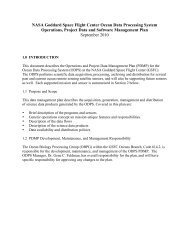
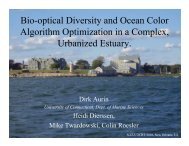
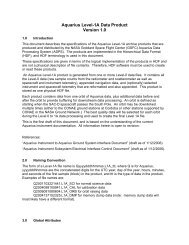
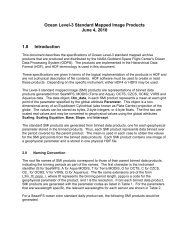
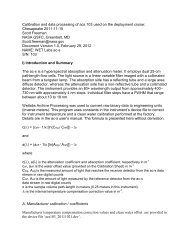
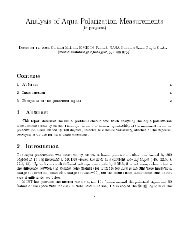
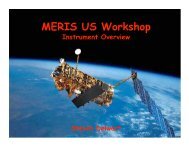
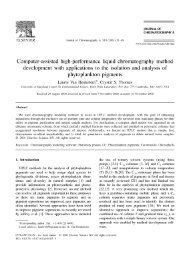
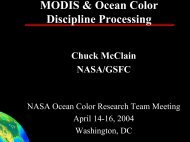
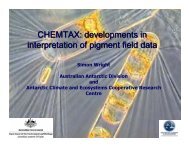
![Franz ocrt_terra_franz.ppt [Read-Only] - Ocean Color - NASA](https://img.yumpu.com/24076593/1/190x146/franz-ocrt-terra-franzppt-read-only-ocean-color-nasa.jpg?quality=85)

